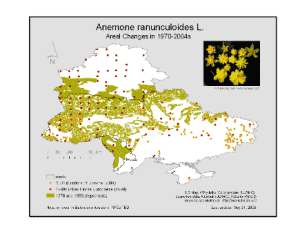Придатко В.І., Коломицев Г.О. Про моделювання ареалу розповсюдження анемони жовтецевої (Anemone ranunculoides L.)
 Моделювання ареалу розповсюдження анемони жовтецевої (Anemone ranunculoides L.) демонструє зміщення місць існування виду у напрямку південних територій регіону GLOBIO-Україна, частково. Дивіться анімацію у видовому профайлі.
Моделювання ареалу розповсюдження анемони жовтецевої (Anemone ranunculoides L.) демонструє зміщення місць існування виду у напрямку південних територій регіону GLOBIO-Україна, частково. Дивіться анімацію у видовому профайлі.
Зміни розповсюдження анемони жовтецевої були прослідковані з викристанням історичних даних, а також матеріалів ГІС та ДЗЗ. Історичні, ГІС та ДЗЗ дані включають:
1) «Хорология флоры Украины» (1986). 2) «Екофлора України» (2004). 3) Атлас лісів СРСР (1973)/Лісні мисливські птахи та звірі – рос., отримано в Національній бібліотеці Вернадського (Київ) – векторізація виконана В.Придатко, О.Іщук, О.Калініченко (УЦМЗР). 4) Карта рослинності Європейської частини СРСР: Аналітичні карти I-IX (Додатки)/Рослинність Європейської частини СРСР. СПб., Наука, 1980.—429 с. 5) Atlas Florae Europaeae (1972-1996), edited by Jaakko Jalas and Juha Suominen, together with Raino Lampinen (Vol. 11)/Updated 2004-05-26 by Mikko Heikkinen – Website at http://www.fmnh.helsinki.fi/english/botany/afe/ . 6) Ліси України у 1990-х, на основі даних ДЗЗ Landsat (УЦМЗР, 2005). 7) Ліси України у 2000-х, на основі даних ДЗЗ Landsat (УЦМЗР, 2005). Історичнікарти 80-х були відскановані, оброблені та оцифровані у середовищі ArcGIS В.Придатко.
Карти, складові анімації змін місць існування у 1970-х та 1980-х є гіпотетичними, переважно із урахуванням локалізації листяних та мішаних лісів. Гіпотетичне розповсюдження виду у 80-х відображає можливе заміщення листяних лісів 70-х необроблюваними лучно-степовими ділянками у 80-х. Дані атласу Florae Europaeae [5] та Екофлора [2] були використані в комбінації з детальними даними ДЗЗ 2000-го року у середовищі ГІС [6, 7]. Анімовані карти виду демонструють значні зміни місць існування анемони жовтецевої за останні 30 років, вид проявив нову тенденцію до експансії південних районів Степової природної зони (региону GLOBIO-Україна). Основні причини таких змін точно не описані, але це може бути у першу чергу землекористування (фрагментация листяних лісів), та можливо також зміни клімату. Цей приклад є кроком до підготовки моделей розповсюдження видів (GLM).
Автори ГІС-карти: В.Придатко (УЦМЗР), Г.Коломицев (ІЗ НАНУ). Детальніше: https://biomodel.info/?page_id=239



2 коментаря
Peter · четвер жовтня 15th, 2009 о 20:32
I liked it. So much useful material. I read with great interest.
Mackeran · субота жовтня 17th, 2009 о 02:30
Very interesting and amusing subject. I read with great pleasure.
Коментарі закриті.